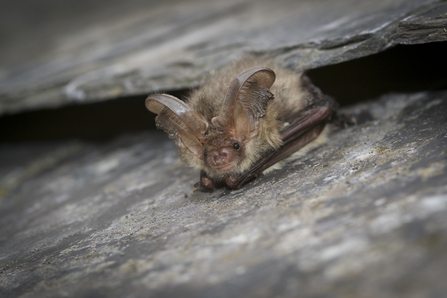
Brown long eared bat by Tom Marshall
There are 13 species of bat that have been found in Suffolk over the past thirty years, from the most common pipistrelle to records of a lone hibernating lesser horseshoe bat. But whatever the species, a fleeting encounter with a bat is probably one of the most magical and rewarding for a wildlife gardener.
Much of what you do elsewhere in the Living Garden, from pond creation to avoiding using chemicals, will impact on the number of bats that visit in that they boost food supplies in the form of invertebrates.
Boosting bats’ food sources
Before you plan any changes, look beyond your garden at what bats already have access to nearby. Try to enhance what is already available because bats live and feed over a wide area. It is worth looking at some of the general advice about attracting wildlife to your garden as the number of invertebrates will directly affect the popularity of your garden.
Habitat piles, sowing wildflower seeds in areas of garden, as well as planting herbs and old fashioned garden annuals will boost insect populations. Larvae and adults alike will also feed on patches of your lawn that are left to grow.
The presence of a trees and shrubs are also desirable in that they can provide both shelter and warmth to insects. Rows of bushes or trees can be created or improved to help encourage concentrations of invertebrates and provide a feeding area for bats.
Creating a pond is perhaps one of the most effective ways to increase invertebrate numbers. Many minibeasts start life in freshwater, emerging only as adults. As one pipistrelle may eat up to 3,000 insects in a night, a pond is an important part of any garden designed to attract bats.
Night scented flowers
In addition to general measures to increase biodiversity and the number of invertebrates in your garden, by growing night-scented flowers like Nottingham catchfly, bramble or white jasmine, you can attract moths and other nightflying insects.
| Plant type | English name |
| Bedding plants | Nottingham catchfly Night-scented catchfly Bladder campion Night-scented stock Sweet rocket Evening primrose Tobacco plant Cherry pie Soapwort |
| Scented herbs | Chives Borage Lemon Balm Marjoram Mint |
| Climbers | European honeysuckle Italian honeysuckle Japanese honeysuckle White jasmine Dogrose Sweetbriar Fieldrose Ivy Bramble |
| Trees and shrubs | Oak Ash Silver birch Field maple Hawthorn Alder Goat willow Guelder rose Hazel Blackthorn Elder |
| Rock plants for walls | Ivy-leaved toadflax Wall pennywort Stonecrop |
Rockeries, habitat piles and ponds
A well-placed rockery can provide an excellent roost site for bats. If you have room try building a rockery using the principles of dry-stone walling. A double-sided wall, filled with stones and incorporating very little soil, can become an attractive feature as mosses and lichens colonise. The spaces will soon become home to invertebrates that bats feed on, as well as a potential roost site.
Alternatively, if an earth bank faced with drystone walling is more suitable to your garden, leave cavities in the centre as well as plenty of small holes in the facing.
Bat boxes
As well as being one of the most threatened types of mammal in Britain, bats are also among the most misunderstood. Bats are fascinating animals – the only true flying mammal, they are attractive small, furry insect eaters that need all the help they can get. Bats need a range of roosting sites, including summer daytime roosts, winter hibernation ones and breeding sites. You can help them find a suitable roost by putting up a simple bat box.
Make the box from rough sawn timber to give the bats something to cling to. It is also vital to check that the wood is untreated as many wood preservatives can kill bats.
The best place to position a bat box is on a tree. Place them in groups round three sides of a tree - bats like to move from one box to another during the day and from season to season as temperatures change. It is a good idea to make sure the area near the box is relatively free of branches to give the bat a clear line of flight.
Try and put the boxes as high as possible above the ground to avoid predators. Some species, such as the noctules, prefer roosts at least five metres off the ground.
If you don't have trees in your garden, bat boxes can also be placed on buildings. A good position is under the eaves of a house as boxes are then sheltered from bad weather.
Bats can take a while to investigate new premises, you can check if the box is being used by looking for crumbly brown or black droppings on the ground.
It is illegal to disturb any bat when it is roosting, or to kill, injure or handle a bat without a licence. If you need further advice please contact us 01473 890089, however if you find a sick or injured bat, please contact the National Bat Helpline on 0345 1300 228.
It is also important to record your bat sightings or roost site.

Useful numbers and addresses
To get involved with local bat conservation you can join The Suffolk Bat Group https://www.suffolkwildlifetrust.org/suffolkbatgroup
For other questions on bat conservation phone the Bat Conservation Trust on 0345 1300 228 or view our FAQ.
